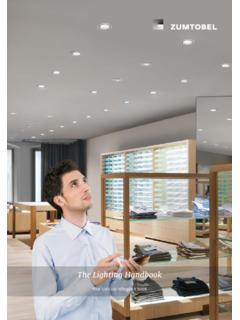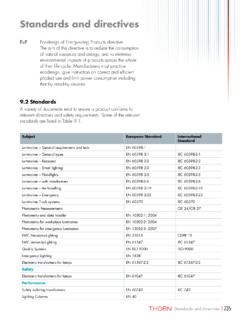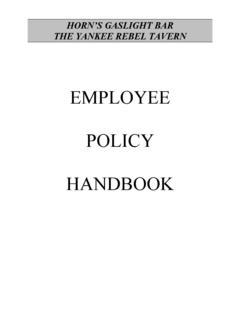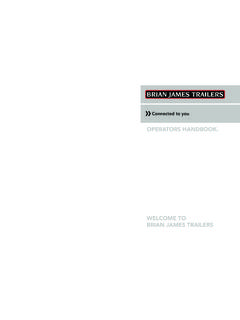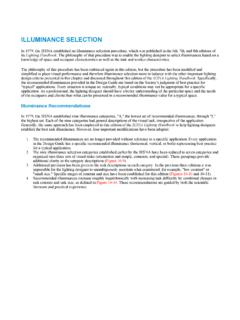Transcription of General Lighting Recommendations
1 Thank you for your interest in energy efficiency! According to the US Department of Energy, 51% of the energy used in commercial buildings is consumed by Lighting systems. The guidelines presented in this document have been organized to support building designers and owners selecting efficient Lighting technologies and practices. This document provides both General technology Recommendations as well as example specifications that can be copied and pasted into project specifications. These Recommendations are based on those of the Illumination Engineering Society of North America (IESNA), the Consortium for Energy Efficiency (CEE) and other non-profit third-party industry groups that promote cost-effective energy efficiency in Lighting . The most current IESNA Handbook should be consulted for more specific design Recommendations .
2 Through your electric utility s energy efficiency programs, CLEAR esult helps building owners, architects and engineers evaluate the benefits of energy efficiency. Building owners are encouraged to assess and address their energy use through a variety of program-related services, including energy performance benchmarking, energy master planning, technical assistance and even public relations support. This document offers objective, third-party Recommendations on best practices in the areas of energy usage and energy efficiency. These services are provided free of charge through your electric utility and are not intended to substitute for the services of paid professionals. General Lighting Recommendations Design Guidelines for Energy Efficient Lighting Systems UNLEASHING THE VALUE OF ENERGY General Lighting Recommendations January 2013 1 LIGHT QUALITY CONCERNS Color Rendering Index (CRI) CRI is a quantitative measure of a light source s ability to reproduce colors of various objects in comparison to an ideal or natural light source.
3 Simply put, it determines how true colors appear. Higher CRI lamps can better reproduce the visible light spectrum and can potentially reduce needed footcandle levels. Product specifications for any lamp will list the CRI of that lamp. With natural light having a CRI of 100, we recommend a CRI greater than 80. Note: Lamp sources of different color temperatures can all have a CRI greater than 80. Color temperature is a measure of the color of a light source in degrees Kelvin. Lower color temperatures (~3000K) are more golden while higher color temperatures (~6000K) have more of a blue tint. Choice of color temperature depends on individual preferences, but we recommend that all light sources in a facility utilize the same color temperature. Illumination Levels IESNA provides detailed horizontal and vertical illumination level Recommendations for thousands of specific space types in their Handbook.
4 These light levels are most commonly expressed in footcandles (fc). Lighting designers should reference the IESNA Handbook as the authority for maximum and minimum footcandle levels in each applicable space type. This ensures appropriate light levels will be maintained while also minimizing energy consumption of the Lighting system. Many existing facilities have much higher than recommended footcandle levels, and this problem is amplified when combined with the visual discomfort of glare . This is often dramatically experienced when working on computers. Glare from overhead lights can actually make it difficult to read most computer screens or monitors since those devices are already backlit. In cases where higher light levels are needed or desired for a specific task or usage type, appropriate illumination is better achieved by moving the light source closer to the task or through supplementary task Lighting , as opposed to simply increasing the light output from an overhead fixture.
5 IESNA recommends the following light levels for various tasks: Public Spaces3 fcSimple Orientation for Short Visits5 fcWorking Spaces for Simple Visual Tasks10 fcTasks with High Contrast and Large Size30 fcTasks with High Contrast and Small Size50 fcTasks with Low Contrast and Large Size50 fcTasks with Low Contrast and Small Size 100 fcCritical Visual Tasks300 - 1000 fcSpecial Visual Tasks These tasks are very specialized, including those with very small or very low contrast critical elements. Visual performance is of critical importance. Recommended illuminance levels should be achieved with supplementary task LIGHT LEVELSO rientation and Simple Tasks These tasks occur in public spaces where reading and visual inspection are only occasionally performed. Visual performance is largely Visual Tasks Visual performance is important for these.
6 Higher light levels are recommended for visual tasks involving low contrast or small size. General Lighting Recommendations January 2013 2 Lighting Power Density (LPD) LPD is the power used by luminaires (including lamps, ballasts, transformers and control devices) per unit area of a building in watts per square foot. For new construction buildings, local building codes dictate the maximum allowed LPD. Energy efficiency incentives for new construction Lighting are paid based on comparing the project s actual LPD with the code requirement. The table below lists the current maximum allowed LPD for various building types according to International Energy Conservation Code 2009 (IECC 2009), along with maximum LPD levels we recommend. Facility TypeIECC 2009 Allowed LPDR ecommended LPD (30% Savings)Automotive : Bar/ : : Care - Lighting POWER DENSITIES General Lighting Recommendations January 2013 3 Lighting CONTROLS Lighting controls reduce energy use from Lighting by dimming or turning off luminaires in day lit or unoccupied spaces.
7 Lighting controls include dimming controls, daylight controls and occupancy controls. Multiple controls may be appropriate for a single building space. We recommend installing Lighting controls wherever appropriate. See the table below for a more detailed description of each control type. Dimming ControlsDimming controls lower light levels in order to reduce the energy consumed. Dimming can be continuous or involve step ControlsDaylight controls dim or turn off lights when ambient light is sufficient. Daylight sensors can be indoor or ControlsOccupancy controls sense occupancy or vacancy in order to turn lights on or off. There are two main types: infrared and ultra-sonic. Controls that use both technologies are the most CONTROL TYPES Lighting TECHNOLOGIES Lighting technologies have various ranges of efficacies (light output per watt input), with incandescent lamps being the least efficacious Lighting technology.
8 LED efficacies are improving every year. See the graph below for a comparison of efficacies of different Lighting technologies. For indoor Lighting , both high- and low-bay, we recommend high performance fluorescent fixtures and ENERGY STAR or DesignLights qualified LED fixtures. ENERGY STAR and DesignLights LED Fixtures General Lighting Recommendations January 2013 4 LEDs are quickly becoming the premier Lighting technology and have the potential to save significant energy and maintenance costs. We recommend that any LED fixture purchased be qualified under ENERGY STAR or DesignLights Consortium programs. These two industry groups rate the best and most reliable LED products on the market. This is the easiest way to choose an LED product that will not fade out or change color before its time. For more information, see the following websites: High Performance T8 Fixtures For most indoor new construction and retrofit applications, we recommend high performance T8 lamp and ballast systems.
9 High performance T8s provide increased light output along with longer lamp life and lumen maintenance at the same wattage as traditional T8s. Improvements to traditional T8s include enhanced rare Earth phosphors, improved gas fill compositions and more robust cathodes, enabling superb color quality (CRI 80) at any color temperature. Premium-efficiency ballasts save energy compared to standard ballasts. The Consortium for Energy Efficiency (CEE) is a non-profit industry group that qualifies high-performance T8 and reduced-wattage T8 lamp and ballast systems. For more information, visit the following website: Typical 2x4 Fixture TypeLumens/LampLumen Maint -enanceCRIR ated Life (hrs)System WattageSystem Lumen OutputENERGY STAR LED 2x4 TrofferN/A 70% 80 25000503,600 2-Lamp High Performance T8 (F32T8)3,100 95% 80 24000546,200 2-Lamp Reduced Wattage T8 (F25T8)2,400 95% 80 24000484,300 2-Lamp Standard T8 (F32T8)2,850 90%7520,000585,700 2-Lamp Standard T12 (F34T12)2,482 88%6020,000724,964 COMPARISON OF TYPICAL INDOOR FIXTURES An important thing to consider when choosing a T8 lamp and ballast system is the ballast factor (BF).
10 This factor is a measure of the lumen output of a ballast relative to a reference ballast. High, low and normal ballast factors are all available as premium ballasts for every type of T8 lamp. This way, you can modify the power input and light output of a T8 fixture by changing the ballast factor in new designs and retrofits. The following chart gives a few examples for a high-performance T8 system. General Lighting Recommendations January 2013 5 Typical 2-Lamp High Performance T8 SystemInitial Lamp LumensBallast Factor (BF)Mean Fixture LumensSystem WattageMean Lumens per WattLow Ballast Factor3,100 Normal Ballast Factor3,100 High Ballast Factor3,100 Very High Ballast Factor3,100 BALLAST FACTOR COMPARISON OUTDOOR Lighting Because LED lamps tend to provide directional light in a more even spread than other technologies, we recommend ENERGY STAR or DesignLights qualified LED fixtures for outdoor illumination.
